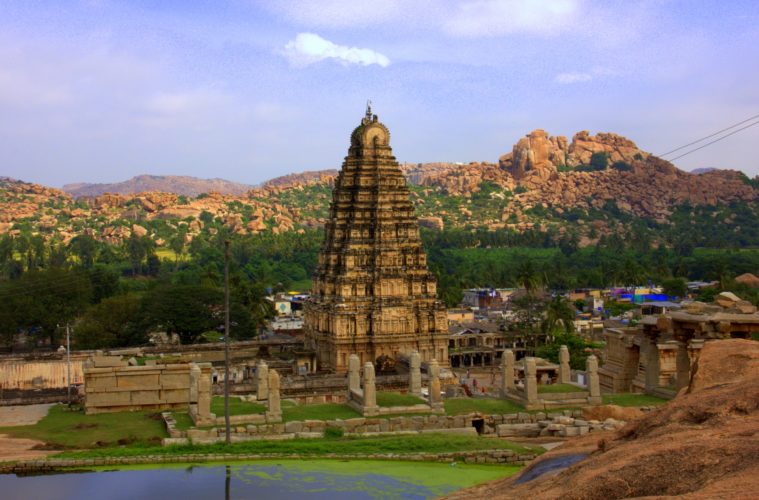My Hampi trip began in Goa, from where a short train ride took me to Hospet. Cutting through the Western Ghats, it is one of India’s most spectacular train routes. On the train, I befriended Lilian, a kind elderly British lady and we bonded well over traveling. She loved India, have visited more than she can remember and was an expert at handling the stress of traveling in my country. In fact, her sharp bargaining skills helped us get a quick autorickshaw and we happily left the train station behind. Hospet in Bellary district of Karnataka is an incredibly dismal place and huge pot-holes made the ride bone jarring. Garbage piles, wallowing bristly boars, slime, and pool sized craters made the first 15 minutes of the ride an absolute nightmare after which the ugly urban sprawl of Hospet melted away. The idyllic Indian countryside unfurled quickly and colourful houses, bejeweled gaudy clothes, curious smiling faces, and an innocent rural hinterland spread warmly like a happy halo.
Table of Contents
The beginning of my Hampi trip
Mustard fields lined the road with neon yellow and lime coloured parakeets squawked noisily from guava orchards. Irrigation channels flowed through paddy fields and little boys, bathing women, and languid buffaloes splashed on them merrily. They stared at us, as our autorickshaw driver greeted them with loud cheers and I fell in love with quintessential rural India. Innocent, curious, and welcoming, rural India is friendly almost to a fault. It took nearly 30 minutes to reach Hampi and at the end of the drive, the famous landscape took over the scenery. Tawny boulders of different sizes were scattered at precarious angles and a nearly nonexistent track meandered through sugarcane groves. The thick, sickly sweet smell of harvesting sugarcane permeated the air and the rocks glowed deep gold in the afternoon sun. It was the most spectacular way of starting my Hampi trip and I simply could not wait to explore.
The main village of Hampi
The main village of Hampi arrived with a trail of excited children, fantastically dressed traveling magicians, and neat mounds of deep yellow bananas. Flowers, vermilion, incense sticks, and coconuts created colourful blobs and souvenir shops sold leatherware from cubby holes. Cheap, clean guesthouses tumbled all the way to the river and the tall pyramidal gopuram of Virupaksha Temple cast elongated shadows on the village. Hampi belying its size, had all the facilities required by a traveler and with free wifi, cafes, lounges, and bakeries, it was a real backpacker’s mecca. In fact, it is a place so global that during my entire Hampi trip, I heard nearly all the major languages of the world and they came in excited babble from every corner of the village.
You may also like: What makes Hampi such a special place?
Coracle boats amazed me throughout my Hampi trip
The sun was setting dipping by the time I reached Hampi and my first evening was spent strolling by the river. Great cafes in Virupapur Gadde tempted me a lot and I waded through sunken relics to get on a coracle boat. Woven from weed, basket-shaped coracle boats are a South Indian specialty and there’s nothing more fun than floating down the eddying water of Tungabhadra on one. The tough little carriers dotted the river like upturned umbrellas and they carried people, goats, bags, and motorcycles across the Tungabhadra river. Virupapur Gadde was more tranquil than the main Hampi village on the opposite bank and though, separated by just a river, it seemed like another planet. In fact, it was such a peaceful place, that I spent all the evenings of my Hampi trip exploring its cafe scene.
Where I learned to slow travel during my Hampi trip
At Virupapur Gadde, ripening paddy fields undulated in waves and cuckoos sang from the lush gardens. Small guesthouses remained hidden behind clusters of banana plantations and rocks grew into formed picturesque hills. Coconut palms, hibiscus, and guavas bordered at the bottom and forgotten, often abandoned ancient temples silhouetted on their peaks. I loved relaxing at Virupapur Gadde and often lounged at the “Goan Corner” restaurant till the sun tinted the sky with reds. Easing into a lazy pace happened almost immediately on my Hampi trip and never before had I enjoyed doing absolutely nothing. The concept of slow traveling was yet to get popular at that time and I had no idea that I evolved into a more relaxed traveler at Hampi in Karnataka.
Hampi is a must visit destination of south India
With the sun setting fast behind the deep bronze boulders, I rushed back to cross over to Kamalapuram and managed to get on the last ferry. Because of dangerous eddies and whirlpools on the Tungabhadra, boats did not ply on the river after sunset and the last ferry for Kamalapuram is scheduled at 6 in the evening. Virupapur Gadde floated away in a dark brooding rocky pile and I watched in amazement as the dusk fell rapidly over the city of the living dead. Huge spotlights lit up the Virupaksha Temple against a velvety dark night and once again I found Hampi’s surreal beauty too bewitching to be true. With so much of history, fascinating natural beauty, and quintessential Indian charm, my Hampi trip was a travel dream come true.
RESPONSIBLE TRAVELING-BECAUSE I CARE

















